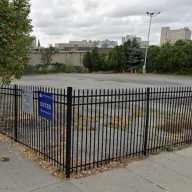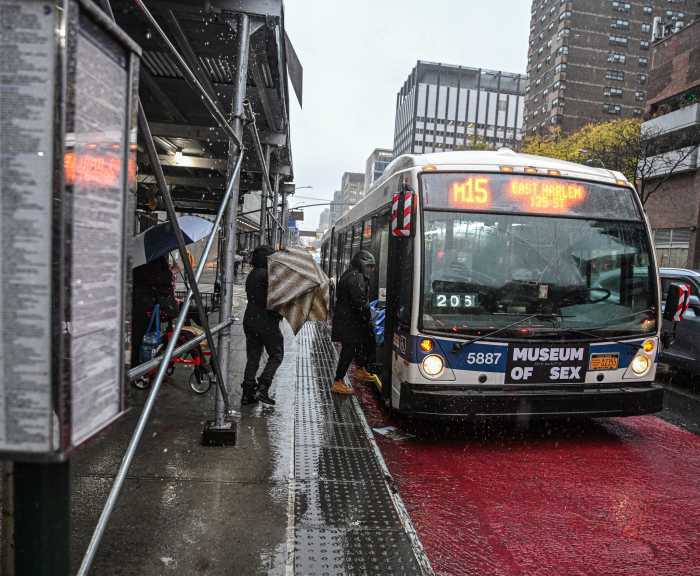It seemed like the coat should be warm enough, but it wasn’t as the wind ripping up Roosevelt Ave. raked faces passing downed grates.
No inviting place to step in. Nowhere to hide.
Step quickly because soles get very cold against the Queens pavement on the coldest night of the season so far. And the steps down to the 7 station are only a valley for the wind rushing up the opposite side.
Stalked by the winter climate that briefly tortures commuters every night, Queens’ homeless spend their nights dodging the wind or relying on shelters for warmth.
Standing suddenly taller on the sidewalk between the place where he works and the shelter where he lives, a Vietnam veteran explained "a homeless man is a working man without a home."
Clean shaven and neatly dressed with a single golden stud in his left ear, he added that of course there were addicts and mentally ill on the streets as well, but "everyone has one foot in a shelter, they just don’t know it."
Tyrone Pough served four years in the military as a radio specialist. One day he lost his job. Then his wife and kids left. Then he lost his home. He has resided at the Salvation Army Borden Ave. Residence in Long Island City for a year now.
Peru Wiley, 38, entered the Navy when he was 17 and served in the Caribbean and the Pacific as a Seaman. At 20, he was out of the Navy and his father had passed away while he was gone. For two weeks he held a job with a bank, until a transit strike. He couldn’t take the crowded spaces and lost his job. He felt alone. He sat in his mother’s house with the lights off, sinking into depression. He turned to crack because it was a thrill.
He got out of jail in March. He has served time for sale of a controlled substance and possession of a gun. He has been at Borden Ave. for more than six months.
"When I was homeless, I was angry. I felt it was everybody’s fault. I felt like I was bivwacking in the jungle, still living in the field . . . When you’re out there, when you’re homeless, you don’t see that you’re doing something wrong. Nobody is there for you so you do it for yourself. ‘F–k it’ is your favorite thing to say . . . you lie to yourself. You’re slick because you could survive the street.
"Then you ride past the houses in Queens, see the chandeliers in the apartments through a window, and you think ‘Damn, Ican’t wait. I long for the peace of being in my own place and shutting the door.’
"You sit in jail and young kids call you Pop" then you realize, he said.
"I’m thankful for another chance – this chance I am getting now." A chance to be back someday with his five-year-old son who lives with a relative in St. Albans.
Keith is 31 and works as a production assistant, where you don’t have to fill out an application with your home address. He has worked on Della Ventura and NY Undercover sets. He also waits tables and does sales – wherever he can find work.
In his DKNY cap and designer-copy black pullover sweatshirt, he spoke of going into the Army at 21 and serving in Panama and the Persian Gulf. He studied computer science at Columbia for a year.
He started doing drugs.
"I’m not going to say homelessness can happen to anyone, because that sounds trite, but it is true . . . Homelessness is in the mind. No one on the street could look at me and tell me Iwas homeless. I didn’t wear it on my sleeve while sitting on a gold mine. The drug element – it’s just right there."
George Jones has been administrator of the Borden Ave. shelter for about a year but has worked with the homeless through not-for-profits since 1989. He said the homeless fall into three categories.
Some "want to get back into the mainstream. Then there are homeless who don’t want that. They have given up on society. They feel abandoned by it. They opt out."
In a way, they are "the classic American – self reliant . . . urban frontiersmen. Society doesn’t fit with them. I’ve known some very sane people who remembered being homeless fondly."
And then there is "the ‘classic’ homeless – the mentally ill or substance abuser who is so overwhelmed they really can’t function. They are automatically out of society."
The Borden Ave. Shelter can handle 410 veterans. The Salvation Army, which has the contract to operate three of the borough’s four city shelters, services and reaches out to 800 homeless people a day in Queens. There is a Briarwood Family shelter and the Jamaica Women’s shelter. The City itself operates a family shelter in Springfield Gardens.
There are 450 single adult shelter beds and 750 units for homeless families in Queens according to the Department of Homeless Services.
And according to Wiley, the City shelters – without the structured programs and restricting contract of Salvation Army shelters – are "worse than prison.
"People come in dirty, stinking, with vermin. They talk to themselves. They have feces all over them. You talk about the dregs of society – you get robbed, they are high in the bathroom at all times of night," Wiley described.
If you are a homeless family in Queens, you need to go to the Emergency Assistance Unit in the Bronx to get into the system. If you are a homeless man, you need to go to Manhattan or Brooklyn. If you are a homeless woman, you can go to the Jamaica assessment shelter.
Or, you can be found by the two Salvation Army teams that patrol 16 hours each day doing outreach in Queens. They work in conjunction with the Police Dept.’s Homeless Outreach Unit. Outreach can get you placed in a shelter without leaving the borough.
Still many prefer to go to one of eight city drop-in centers where they have a chance to bathe, eat, and receive some medical services and referrals. If they still do not want to go to a city shelter, they may be sent to one of the synagogues or churches around the city whose volunteers prepare beds for them and stay with them through the night. To become part of this synagogue-church network you just have to prove you have enough volunteers and contact the Partnership for the Homeless which coordinates the shelters. The City buses the homeless to the locations and provides sheets and beds where necessary.
Nineteen Churches in Queens open their rectories and basements to the homeless through this program.
Sacred Heart in Bayside has been welcoming five homeless women to their parish each winter night for over 14 years, Monsignor Thomas S. Donovan explained. The warm-hearted priest walked into the rectory meeting room to welcome "our guests" Tuesday evening as volunteers prepared hot chocolate and sandwiches. In their 60s and 70s, one woman still identified herself as being from a Queens Village parish while Father Tom laughed at his French when conversing with another and a third put away her coat beneath a night table a parishioner had made.
Theresa Harris, former principal of P.S. 29 in College Point, will be directing the shelter for the first time this year. She couldn’t volunteer before because she had to take full-time care of her son, who passed away in February. Since he was a veteran, she took his clothing to the Borden Ave. shelter, and it made her sad. "When God called him, I felt it meant it was time for me to take care of someone else."
Anthony Ellis of the St. Pascal Baylon congregation in St. Albans just started volunteering at their winter shelter, which takes in homeless bused by the City from drop-in centers once a week, simply because the minister stood up and asked for volunteers. That was seven years ago.
He remembers one downsized engineer, about 35 or 40, who said it was "the first place he’d been to that he felt he was at home." Another guest said his mother lived right down the street.
Parish volunteers cook an entire meal for the ten guests at St. Pascal’s each week and "most of them are young,"according to the shelter director Cecil Perez. "Some of them are working in Manhattan, but they have no place to stay. That is why they go to a shelter."






























